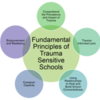Secure, trusting bonds are essential if young people are to grow, learn, and thrive (Baumeister, 2011; Brendtro, Brokenleg, & Van Bockern, 2005; Shulevitz, 2013).
Today there are literally millions of young people disconnected and living in violent communities with over stressed families and schools that are depersonalized. They traverse dangerous communities and the ecology in which they live is one of extreme levels of toxic stress.
The most troubled and troubling kids display behaviors that increase their disconnection and also increase their alienation from caring adults. These kids get kicked out of everything and often as they get into high school are expelled to nowhere.
Youth at risk experience pervasive emotional pain and react with pain-based behavior (Anglin, 2014).
These are our most difficult students. They are experts at “biting the hand that attempts to feed them” and can quickly get untrained and unaware educators into escalating power struggles.
The behavior of relationship-resistant youth is functional and purposeful. In other words, the young person is trying to accomplish something and the adult’s challenge is to detect what that might be (Anderson & Seita, 2005).
Problem behavior is often a means of coping with a world filled with danger, abuse, neglect, and abandonment. Seen in that light, problems can be a sign of health, energy, self-preservation, and self-determination. ( Seita, 2005)
These young people are simply trying to protect themselves!
It seems crazy to most teachers and educators because of the disconnect in lived experiences. Young people raised in a dangerous ecology develop skills to defend themselves against more “pain”. This behavior become self-defeating in our school systems.
Unaware and untrained schools often treat pain based student behaviors with more pain.
As Bessel van der Kolk puts it:
“ Faced with a range of challenging behaviors caregivers have a tendency to deal with their frustration by retaliating in ways that often uncannily repeat the children’s early trauma.”
Bar
Connecting with relationship resistant children and youth is an endurance event.
The teachers/educators or other adults face lots of obstacles including: our natural biology, brain based warning systems ( fight/flight/freeze responses ), distorted and pessimistic private logic of troubled young people ( as well as some staff ) and a lack of training in most of this in the vast majority of teacher preparation programs!
The brains alarm system and danger detector, the amygdala, in your most troubled youth has been reset and keeps many of these young people in a persistent state of alarm. Many are hyper-vigilant and can mis-interpret signals we send as coercive and/or hostile.
Most of what we see behaviorally in not personal (although as teachers it can certainly feel that way)
These hurt young people are attempting to avoid more PAIN.
Describing troubled emotions as “pain” is more than a metaphor, and the phrase “hurt feelings” is literally true. Researchers have found that physical and social pain operate in similar ways in the human brain (MacDonald & Jensen-Campbell, 2010).
Research is Clear-
The research is clear: at-risk youth are a product of at-risk communities.
“We recognize the role the environment plays in the health and well-being of all creatures. No one blames a fish for dying in polluted water.” – John Seita
If schools are to support and assist these troubled young people they must shift from flaw-fixing to building environments where all young people thrive.
Pain Based Behaviors-
When youth show pain-based behavior, one should not take it personally.
We must demonstrate the ability to handle pain based behaviors with respect, calmness and clarity. We must learn the skill of “emotional first aide” calming the student, connecting with them and then…..teaching them to problem solve and handle conflict in positive ways.
We need to avoid being trapped in our own maladaptive private logic (e.g., “This kid is being a jerk. I do not have to take that crap”).
Trust in built in small ways over time. Once they trust…. Their behavior will change.
Here are the 4 Universal Growth Needs of All Children and Youth. How does your school answer these for your most troubled kids?
- Belonging- Am I important to somebody here?
- Mastery- Am I good at something here?
- Independence- Can I influence my world here?
- Generosity- How can I share my gifts to help others here?
Let me know what you think... Michael




Comments (4)